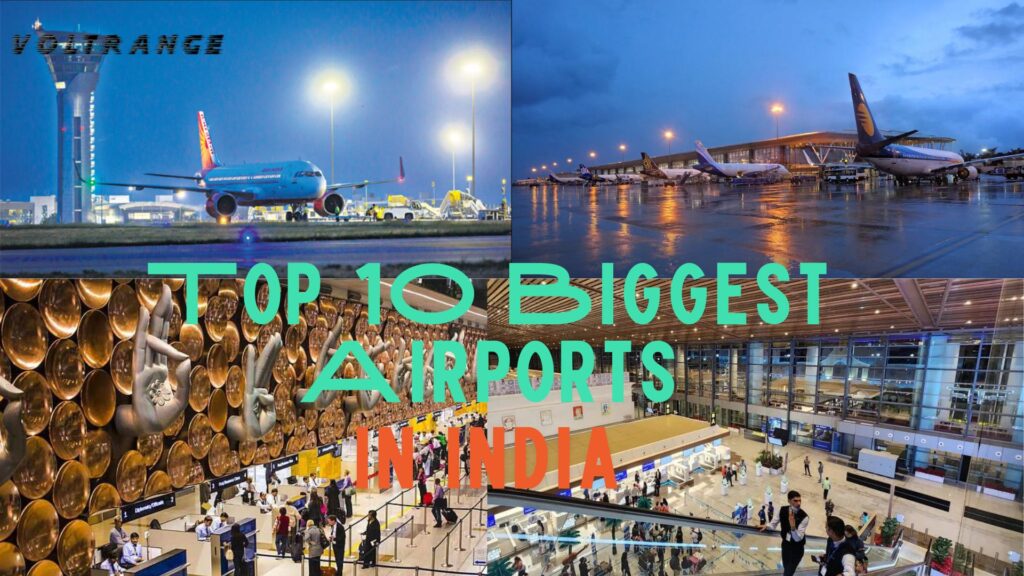
Top 10 Biggest Airports in India
Biggest Airports in India: As of 2024, India is home to over 100 operational airports, with 137 in total. While most serve domestic routes, around 34 international airports handle significant passenger and cargo traffic. Some of these airports are among the largest in the world, with advanced infrastructure and high capacity. In this guide, we’ll explore the top 10 largest airports in India, providing insights into their size, operations, and significance.
1. Rajiv Gandhi International Airport, Hyderabad
Rajiv Gandhi International Airport, located in Shamshabad, Hyderabad, is the largest airport in India, covering 5,500 acres. It is a pioneer in e-boarding facilities for both domestic and international passengers and features 12 Passenger Boarding Bridges, 19 Self-check-in Counters, 46 Immigration Counters, and a VIP Lounge. From April 2022 to March 2023, it handled over 21 million passengers and 140,000 tonnes of cargo. The airport is designed to accommodate heavy volumes, making it a key transportation hub in the country.
2. Indira Gandhi International Airport, New Delhi
Spanning 5,106 acres, Indira Gandhi International Airport in New Delhi is the busiest in India. Located in Palam, it features four runways and can handle over 37 million passengers annually. Recent developments, such as the construction of dual elevated eastern cross taxiways and an additional runway completed in 2023, have enhanced its operational capacity, solidifying its role as a major gateway for both domestic and international flights.
3. Kempegowda International Airport, Bangalore
Kempegowda International Airport in Bangalore ranks third, covering 4,000 acres. It was the first airport in South India to feature two parallel runways and is known for its sustainability initiatives, being fully solar-powered. The airport opened in 2008, and its second terminal, constructed in December 2022, further expanded its capacity to handle increasing travel demands. This airport plays a crucial role in connecting Bangalore to international destinations.
4. Manohar International Airport, Goa
Opened in January 2023, Manohar International Airport, also known as Mopa Airport, spans 2,132 acres in North Goa. Named after a former Defense Minister and Chief Minister of Goa, this airport serves as a second gateway for international flights to the state. It features modern amenities, including an ATC tower, cargo terminal, and well-equipped food court. Its strategic location and high-end facilities are expected to boost tourism and the local economy.
5. Dabolim Airport, Goa
Situated on 1,700 acres, Dabolim Airport serves both domestic and international flights and is part of a naval airbase. Established in 1955, it remains a vital gateway to Goa, a popular tourist destination known for its beaches. In 2013, a fully integrated terminal was built to enhance its passenger-handling capacity, making it a key entry point for visitors to the region.
6. Netaji Subhash Chandra Bose International Airport, Kolkata
As the largest airport in Eastern India, Netaji Subhash Chandra Bose International Airport occupies 1,640 acres, located just 15 km from Kolkata’s city center. It features two parallel runways and three terminals, handling up to 18 million passengers annually. Equipped with advanced landing systems (CAT-II ILS) and numerous check-in and immigration counters, it is one of the busiest airports in India.
7. Birsa Munda Airport, Ranchi
Birsa Munda Airport in Ranchi covers 1,568 acres and primarily serves domestic flights. Opened in March 2013, the airport has seen upgrades in passenger services, including new aerobridges and modern cargo facilities. Named after a legendary tribal freedom fighter, this airport can handle over 2.4 million passengers annually, contributing to the region’s growing connectivity.
8. Chhatrapati Shivaji International Airport, Mumbai
Spanning 1,500 acres, Chhatrapati Shivaji International Airport is the second-busiest airport in India. Located in Mumbai, it accommodates over 60 million passengers annually and features one of the country’s tallest ATC towers. With extensive facilities including large parking areas, business lounges, and retail outlets, it is a crucial hub for both domestic and international travelers.
9. Dr. Babasaheb Ambedkar International Airport, Nagpur
Dr. Babasaheb Ambedkar International Airport in Nagpur covers 1,355 acres and is located just 8 km from the city center. A new terminal built in 2008 allows the airport to handle up to 550 passengers during peak hours. Equipped with modern baggage handling and security systems, the airport plays a significant role in the region’s air traffic management.
10. Cochin International Airport, Kochi
Cochin International Airport in Kerala, covering 1,300 acres, is notable for being the world’s first fully solar-powered airport. Developed under a public-private partnership, it features three passenger terminals and an exclusive cargo terminal. As the largest airport in Kerala, it sets a standard for sustainability and infrastructure development in Indian airports.
Conclusion
These top 10 airports represent the largest and most significant aviation hubs in India as of 2024. While some of these airports have been operational for decades, others are newly established, reflecting the country’s rapid growth in air travel and infrastructure. With continued expansion and modernization, these airports will remain vital to India’s transportation network, handling millions of passengers and fostering economic growth. Stay tuned for updates as India’s aviation landscape continues to evolve.





More Stories
Is Sansui an Indian Company? True Or Not
Handles Salary Revision and Appraisal: 10 Fact
Is Walmart an Indian Company? True Or Not